Tungnath Temple: The Highest Shiva Shrine in the World 12k ft
Tungnath Temple, dedicated to Lord Shiva, is the highest Shiva temple in the world and the highest of the five Panch Kedar temples. It is located in the Rudraprayag district of Uttarakhand, India at an altitude of 3,680 meters (12,106 feet). The trek to Tungnath Temple is a challenging one, but the views from the top are breathtaking.
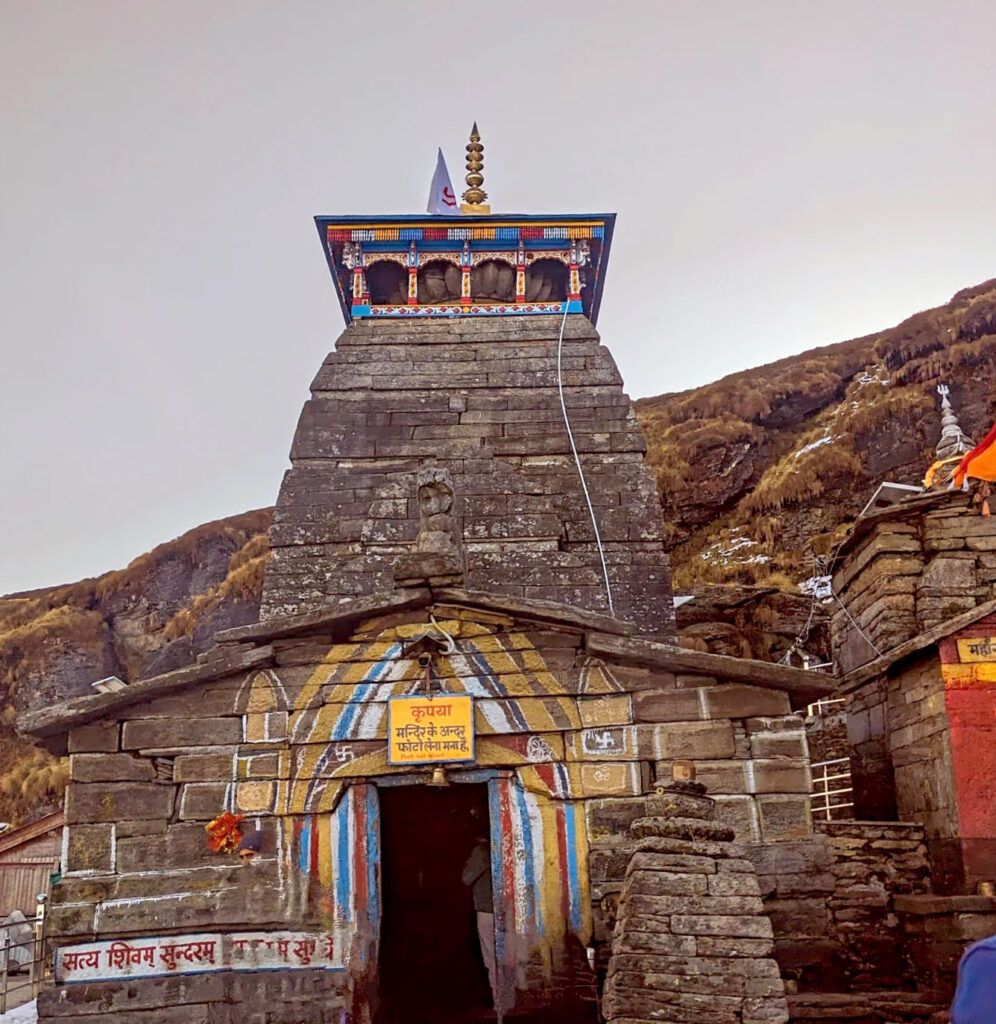
Contents
- 1 Tungnath Temple History:
- 2 Legend of Tungnath Temple:
- 3 Significance of Tungnath Temple:
- 4 Myths of Tungnath Temple:
- 5 Specialty of Tungnath Temple:
- 6 Architecture of Tungnath Temple:
- 7 Tungnath Temple Timing:
- 8 Tungnath Temple Trek:
- 9 Tungnath Temple Altitude:
- 10 Places to visit near Tungnath Temple:
- 11 FAQ:
- 12 How to Reach Tungnath Temple:
- 13 Google Maps:
Tungnath Temple History:
The Tungnath Temple is believed to be over 1,000 years old, and its history is closely associated with the Pandavas, the heroes of the Mahabharata epic. According to legend, after the Kurukshetra War, the Pandavas were remorseful for killing their own kin and sought Lord Shiva’s forgiveness. Lord Shiva evaded them, but the Pandavas were determined to find him.
They eventually tracked Shiva down to Tungnath, but he disguised himself as a bull. The Pandavas recognized Shiva’s divinity and tried to seize him, but he disappeared into the ground, leaving behind his arms, torso, head, and face. The Pandavas built temples at each of these sites, which became the five Panch Kedar temples.
The Tungnath Temple is a simple stone structure with a black granite idol of Shiva’s arms. The temple is surrounded by snow-capped peaks and meadows, and the views from the temple are breathtaking.
In addition to its religious significance, the Tungnath Temple is also a popular trekking destination. The trek to Tungnath from Chopta is a relatively easy one, and it offers stunning views of the surrounding mountains and valleys.
Read More>> Panchsagar Shaktipeeth Uttarakhand
Legend of Tungnath Temple:
There are two main legends associated with the Tungnath Temple:
The Pandavas and the Bull
According to the Mahabharata, the Pandavas were seeking Lord Shiva’s forgiveness for killing their cousins in the Kurukshetra War. Shiva disguised himself as a bull and fled to the Garhwal Himalayas. The Pandavas followed him, but he disappeared into the ground. The Pandavas then built five temples at the places where they found different parts of the bull’s body. These five temples are collectively known as the Panch Kedar, and Tungnath is one of them.
Rama and the Moon
Another legend says that Lord Rama meditated at Chandrashila Peak, which is near Tungnath Temple, after killing Ravana. The name “Chandrashila” means “Moon Rock,” and it is said that Rama received the blessings of the Moon God here.
Both of these legends make Tungnath Temple a sacred place for Hindus. It is also a popular trekking destination, as the temple is located at an altitude of 3,680 meters (12,073 feet). The trek to Tungnath is challenging, but it is worth the effort for the stunning views of the Himalayas and the spiritual experience of visiting the temple.
In addition to the two main legends, there are a number of other stories and myths associated with Tungnath Temple. One story says that the temple was built by Arjuna, one of the Pandavas. Another story says that the temple was built by Ravana, the demon king of Lanka. Still another story says that the temple was built by the gods themselves.
Read More>> Ram Mandir Ayodhya | Shri Ram Janmabhoomi
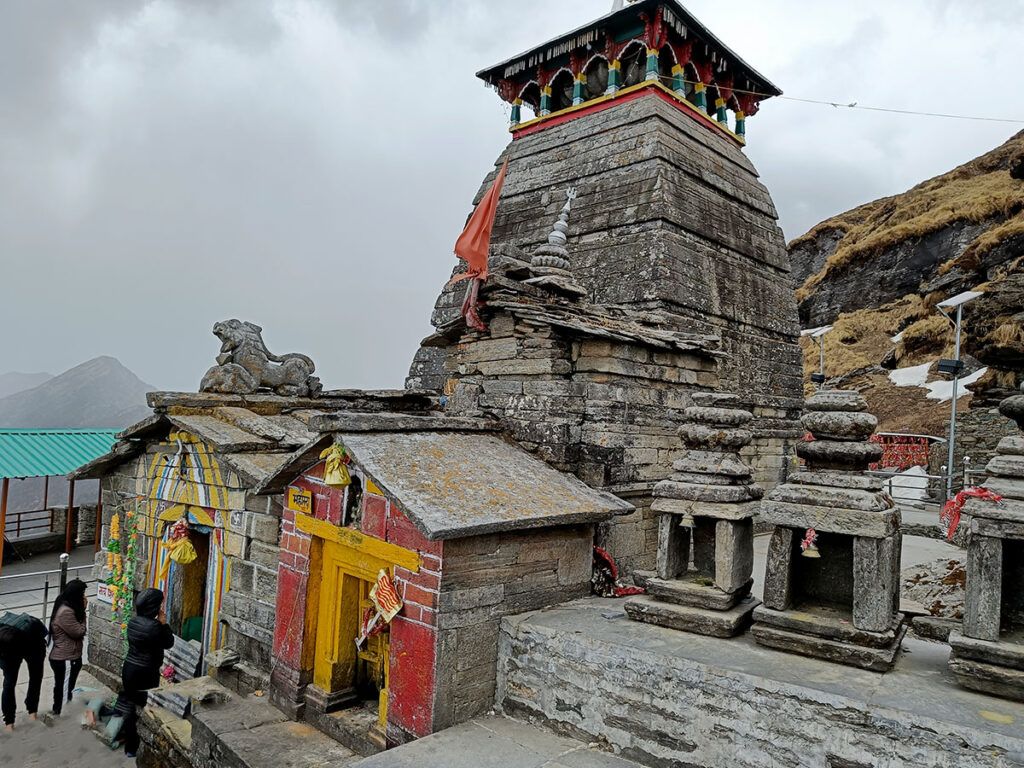
Significance of Tungnath Temple:
- One of the five Panch Kedar temples, dedicated to Lord Shiva.
- Believed to have been built by the Pandavas to atone for their sins.
- Place where Lord Rama is believed to have meditated.
- One of the most sacred places in Hinduism.
- Popular pilgrimage and tourist destination.
Myths of Tungnath Temple:
Tungnath Temple is associated with a number of myths and legends, some of which are as follows:
- The Pandavas and Lord Shiva: According to the Mahabharata, the Pandavas, after the Kurukshetra War, wanted to seek forgiveness from Lord Shiva for the sins they had committed during the war. They traveled to the Himalayas in search of Shiva, but he disguised himself as a bull and disappeared into the ground. The Pandavas followed the bull, but it split itself into five parts and appeared at five different locations. The Tungnath Temple is said to be the place where the arms of the bull appeared.
- Lord Rama and Ravana: Another myth associated with Tungnath Temple is that Lord Rama and his brother Lakshmana meditated at the nearby Chandrashila Peak after defeating Ravana in the Ramayana. It is believed that Rama and Lakshmana had come to Chandrashila Peak to seek forgiveness from Lord Shiva for killing Ravana, who was a Brahman.
- Ravana’s penance: Another myth associated with Tungnath Temple is that the demon king Ravana also performed penance at Chandrashila Peak to please Lord Shiva. It is said that Ravana had come to Chandrashila Peak to seek Shiva’s help in defeating his enemies.
- The speaking mountain: There is also a myth associated with a rock near the Tungnath Temple known as Ravana Shila. It is said that Ravana Shila was once able to speak and that it would tell Ravana about the future. However, Ravana became so arrogant that he started to challenge Shiva himself. Shiva, in anger, cursed Ravana Shila and made it mute.
Read More>> Enchanted Pashupatinath Temple: 5th Century Sacred Hindu Temple
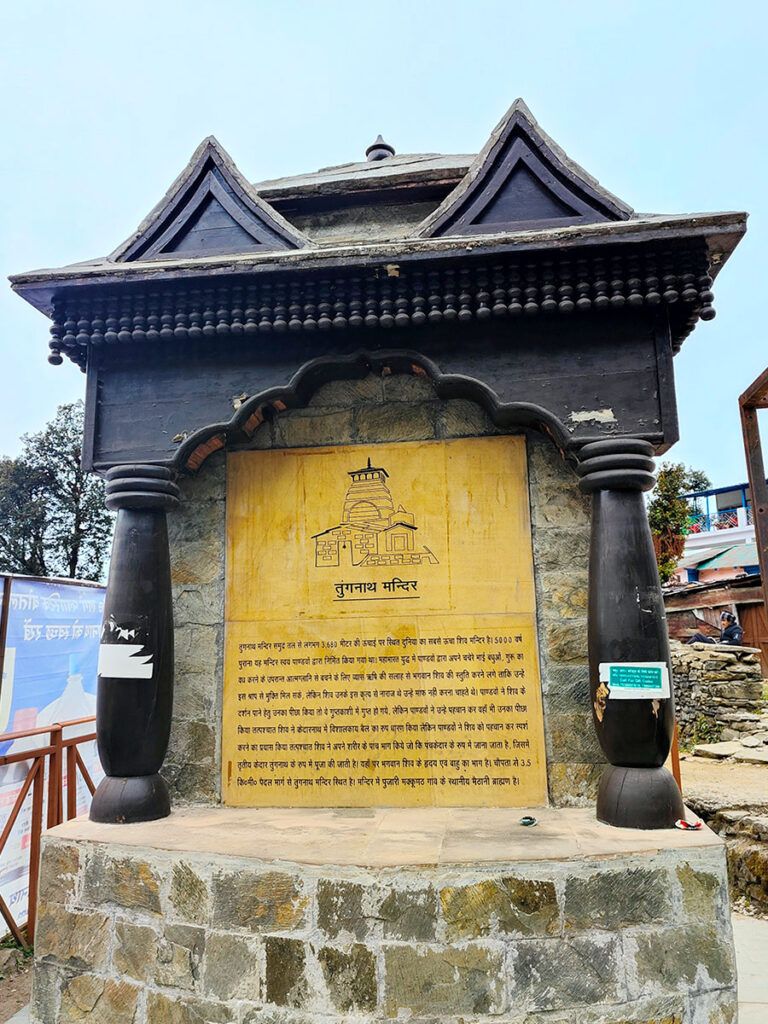
Specialty of Tungnath Temple:
- Highest Shiva temple in the world: Tungnath Temple is situated at an altitude of 3,680 meters (12,106 ft), making it the highest Shiva temple in the world.
- One of the Panch Kedar temples: Tungnath Temple is one of the five Panch Kedar temples, which are dedicated to Lord Shiva and are located in the Garhwal Himalayas of Uttarakhand. The other four Panch Kedar temples are Kedarnath, Rudranath, Madhyamaheshwar, and Kalpeshwar.
- Mythological significance: Tungnath Temple is associated with the Pandavas, heroes of the Hindu epic Mahabharata. It is believed that the Pandavas built the Tungnath Temple to worship Lord Shiva and seek forgiveness for the sin of killing their cousins, the Kauravas, in the Mahabharata war.
- Natural beauty: Tungnath Temple is located amidst the majestic Himalayas, offering stunning views of snow-capped peaks, lush green meadows, and alpine forests. The trek to the temple is also a popular tourist attraction, offering visitors a chance to experience the natural beauty of the Himalayas.
Read More>> Pancharama Kshetras: Kartikeya Breaks the Shivalinga into 5
Architecture of Tungnath Temple:
The Tungnath Temple is built in the North Indian style of architecture, with a tall stone edifice, large mandapa, and a conical rock formation that is worshipped as the Shiva lingam. The temple is surrounded by a number of smaller shrines, including one dedicated to the goddess Parvati.
The main temple features a paraboloid planar tower, divided into sections, and topped by an amalaka (notched disk)+kalasa (urn) finial. The amalaka is obscured by the pyramidal roof meant to prevent snow buildup on the temple. The vimana (the entire structure containing the sanctum and the tower above it) is connected to a single hall with a sloping roof. The hall would be termed mahamandapa.
The temple is made of stone and is decorated with intricate carvings. The entrance to the temple is flanked by two large stone statues of Nandi, the bull mount of Lord Shiva. The sanctum sanctorum of the temple houses a black stone Shiva lingam, which is said to be self-manifested (swayambhu).
The Tungnath Temple is a popular pilgrimage site for Hindus from all over India. The temple is open to visitors from April to October, during the summer months. The best time to visit the temple is during the monsoon season (June to September), when the surrounding mountains are lush and green.
Read More>> Beyond Belief: Exploring India’s Top 10 Temples
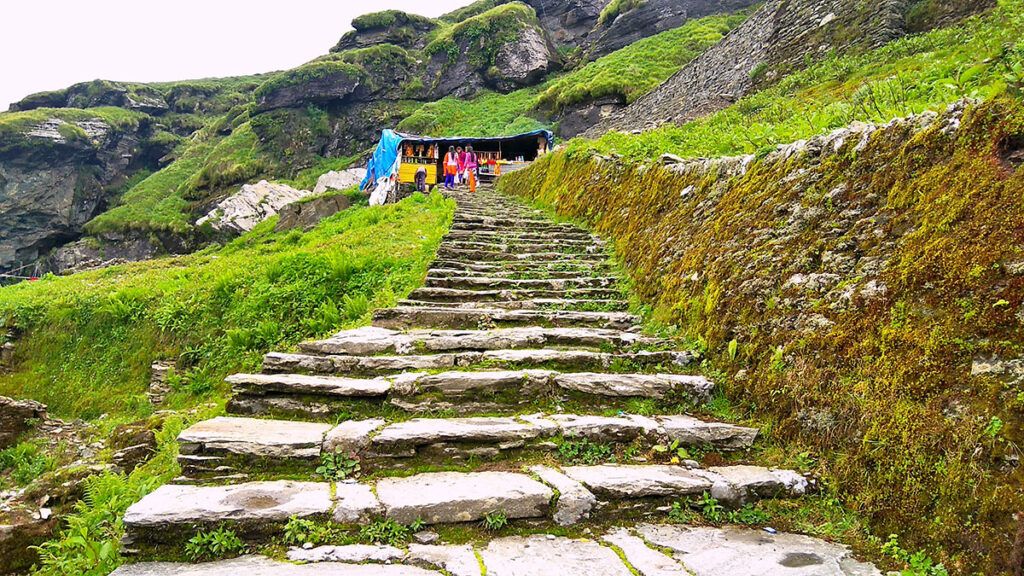
Tungnath Temple Timing:
Tungnath Temple is open from 6:00 AM to 7:00 PM daily. It is the only Panch Kedar temple accessible throughout the year. However, the temple is closed during the winter season after Diwali, and the image of the deity is moved to Mukunath which lies 19 km away from Tungnath by the temple priests during this time. The closing date of Tungnath Temple is announced on the occasion of Dussehra.
Please note that the Tungnath Temple is currently closed for the winter season, and will reopen on May 3, 2024.
Tungnath Temple Trek:
Tungnath Temple trek is one of the most popular treks in the Himalayas, and for good reason. It is a moderately easy trek that takes you through some of the most beautiful scenery in the region, including lush forests, expansive grasslands, and snow-capped mountains. The trek also culminates in a visit to the Tungnath Temple, the highest Shiva temple in the world.
The trek starts from the village of Chopta, which is located about 2700 meters above sea level. From Chopta, the trail winds its way up through the forest, with stunning views of the surrounding mountains. After about 2 kilometers, the trail reaches a meadow known as Chandrashila. Chandrashila is a popular spot to stop for lunch and enjoy the views.
From Chandrashila, the trail continues to climb up to the Tungnath Temple. The temple is located at an altitude of 3680 meters, and it offers breathtaking views of the Himalayas. The temple is also home to a sacred Shivling, which is said to be one of the five Panch Kedars, the most important Shiva temples in the Himalayas.
The Tungnath Temple trek is a great option for trekkers of all levels of experience. The trek is relatively short and easy, but it still offers stunning scenery and a challenging climb. The best time to do the trek is during the summer months, from May to June, when the weather is pleasant and the trails are snow-free. However, the trek can also be done during the winter months, but it is important to be prepared for cold weather and snow.
Read More>> Yamunotri Temple – Complete Guide
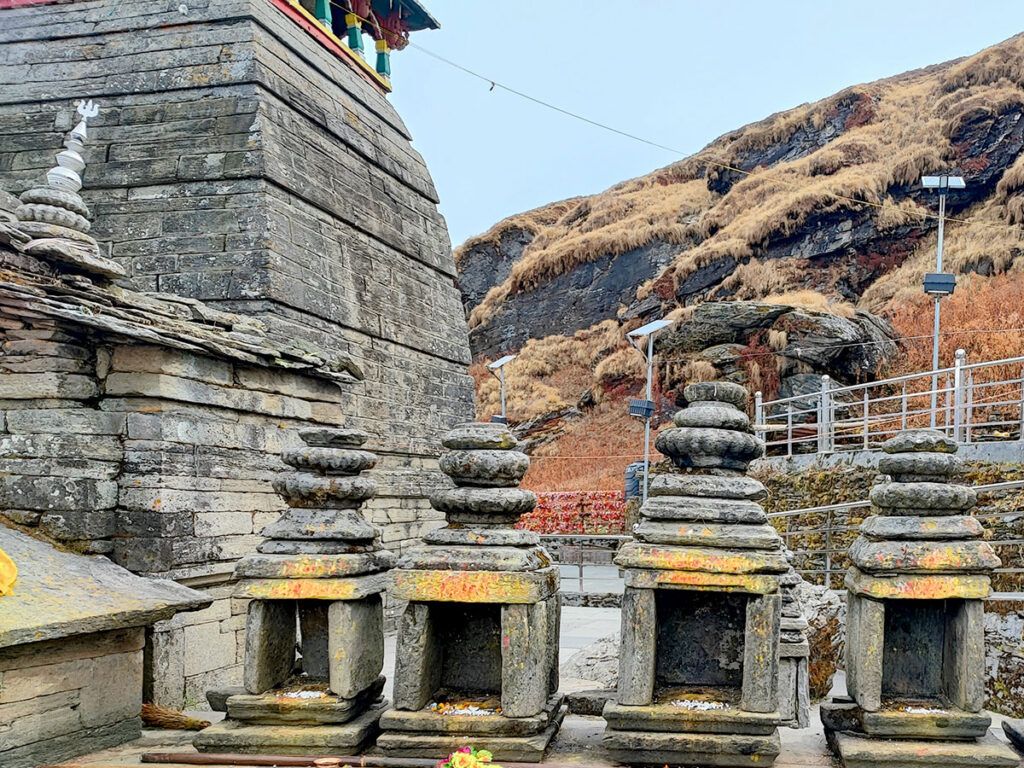
Tungnath Temple Altitude:
Tungnath Temple is located at an altitude of 3,690 m (12,106 ft) in the Garhwal Himalayas of Uttarakhand, India. It is the highest Shiva temple in the world and the third highest of the Panch Kedars, a group of five Shiva temples that are considered to be among the most sacred in Hinduism.
The Tungnath Temple is a popular trekking destination, offering stunning views of the surrounding mountains and valleys. The trek to the temple is moderately difficult and takes about 3-4 hours from the base village of Chopta.
The temple is believed to have been built by Arjuna, one of the Pandava brothers from the Mahabharata. Legend has it that Arjuna obtained the blessings of Lord Shiva at Tungnath after the Kurukshetra war.
Read More>> Shri Jogadya Shaktipeeth, Kshirgram, West Bengal
Places to visit near Tungnath Temple:
Chandrashila: Chandrashila is a peak located close to Tungnath. It offers breathtaking panoramic views of the Himalayan range, including Nanda Devi, Trishul, and Chaukhamba peaks. The trek to Chandrashila starts from Tungnath, making it a popular destination for adventure enthusiasts.
Deoria Tal: Deoria Tal is a pristine lake surrounded by lush greenery and snow-capped mountains. It is a trek of moderate difficulty and offers stunning reflections of Chaukhamba peaks in its clear waters.
Rudranath Temple: Rudranath is another sacred Panch Kedar temple dedicated to Lord Shiva. It is located at a higher altitude and requires a trek to reach. The trek offers beautiful views of the Garhwal Himalayas.
Madmaheshwar Temple: Madmaheshwar is the fourth temple in the Panch Kedar circuit and is known for its tranquil surroundings. The trek to Madmaheshwar takes you through scenic landscapes and provides an opportunity to experience the local culture.
Kanchula Korak Musk Deer Sanctuary: If you are interested in wildlife and nature, you can visit the Kanchula Korak Musk Deer Sanctuary. The sanctuary is home to a variety of flora and fauna, including the endangered musk deer.
Ukhimath: Ukhimath is a small town and a winter seat of the Kedarnath shrine. It serves as a base for treks to various nearby destinations, including Tungnath and Deoria Tal. The town has ancient temples and offers a serene environment.
Kalimath: Kalimath, located near Ukhimath, is famous for its temple dedicated to the Goddess Kali. It is a scenic spot with spiritual significance and can be visited during the trekking routes in the region.
Gopeshwar: Gopeshwar is the administrative headquarters of the Chamoli district and is known for its ancient temples, including the Gopinath Temple. The town is surrounded by lush greenery and offers a peaceful atmosphere.
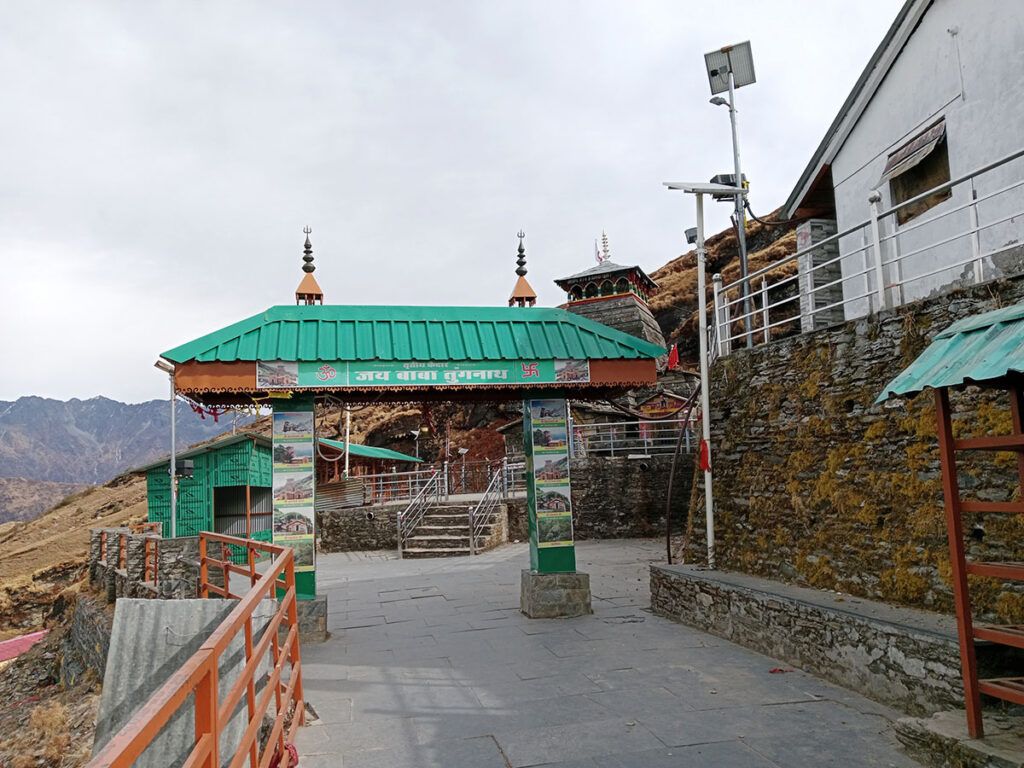
FAQ:
Q: Where is Tungnath Temple located?
A: Tungnath Temple is located in the Rudraprayag district of Uttarakhand, India, at an altitude of 3,680 meters. It is one of the five Panch Kedar temples dedicated to Lord Shiva, and is considered to be the highest Shiva temple in the world.
Q: When is the best time to visit Tungnath Temple?
A: The best time to visit Tungnath Temple is during the summer months (April to June) and the autumn months (September to November). The weather is pleasant during these months, and the views of the surrounding mountains are spectacular. The temple is closed during the winter months (December to March) due to heavy snowfall.
Q: What are the things to do at Tungnath Temple?
A: In addition to visiting the temple and offering prayers, there are several other things to do at Tungnath Temple, such as:
- Trek to Chandrashila: Chandrashila is a peak located about 1 kilometer from Tungnath Temple. It offers stunning panoramic views of the Himalayan peaks, including Nanda Devi, Trishul, and Kedarnath.
- Visit the Tungnath Wildlife Sanctuary: The Wildlife Sanctuary is home to a variety of wildlife, including snow leopards, Himalayan tahrs, and musk deer.
- Enjoy the scenic beauty: This shrind is located in a beautiful setting, surrounded by meadows, forests, and mountains. Visitors can enjoy the scenic beauty by taking walks, hiking, or simply relaxing in the natural surroundings.
Q: What are the things to avoid at Tungnath Temple?
A: Tungnath Temple is a sacred place, and there are certain things that visitors should avoid, such as:
- Littering: Visitors should avoid littering the temple premises and the surrounding areas.
- Loud noises and music: Visitors should avoid making loud noises or playing music in the temple premises.
- Taking photographs inside the main sanctum of the temple: Visitors are not allowed to take photographs inside the main sanctum of the temple.
- Touching or tampering with the ancient artifacts and structures: Visitors should avoid touching or tampering with the ancient artifacts and structures in the temple complex.
- Smoking or consuming alcohol: Visitors should avoid smoking or consuming alcohol within the temple premises.
How to Reach Tungnath Temple:
By Air:
The nearest airport is the Jolly Grant Airport in Dehradun, which is approximately 220 kilometers away from Tungnath. From the airport, you can hire a taxi or take a bus to reach Rudraprayag, and then proceed to Tungnath.
By Train:
The nearest railway station is Rishikesh, which is about 215 kilometers away from Tungnath. From Rishikesh, you can hire a taxi or take a bus to reach Rudraprayag and then continue your journey to Tungnath.
By Road:
- Rudraprayag to Ukhimath:
- Tungnath is accessible from Rudraprayag by road. You can reach Rudraprayag by bus or taxi.
- From Rudraprayag, take a bus or taxi to Ukhimath, which is about 40 kilometers away.
- Ukhimath to Chopta:
- From Ukhimath, Chopta is approximately 30 kilometers away. You can hire a taxi or take a shared jeep to Chopta.
- Chopta to Tungnath:
- From Chopta, Tungnath is around 3.5 kilometers away. You can either trek or hire a local taxi to reach Chopta.
- Trek to Tungnath:
- The trek from Chopta to Tungnath is a well-marked trail and takes about 2-3 hours, depending on your pace. The trek is moderate in difficulty.
For more details on Yatra visit Official Uttarakhand Tourism Website.

One Comment